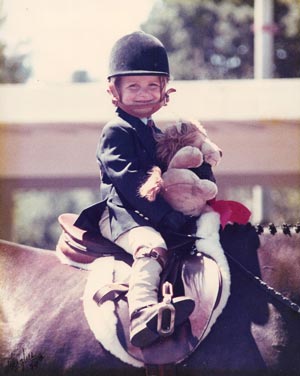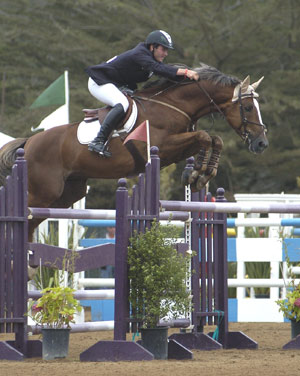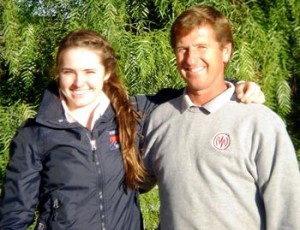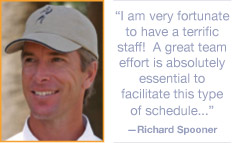By Laura Ware
Ten riders are heading to Colorado in late July to represent Zone 10 at the North American Junior and Young Rider Championships. Congratulations to all who participated in the trials– successfully competing at 1.40 is a huge accomplishment. Young Rider Team Member Paige Dotson was generous enough to share her trials experience. Part of Zone 10’s Gold Medal winning ‘B’ Team last year in Virginia, Dotson, 17, is hoping to strike a repeat performance at Young Riders this year participating on the ‘A’ Team.
Laura: Please tell us a bit about your Young Rider horse.
Paige: I am taking Friponnier II CH (aka Flip) to the Young Riders championships. He is a 16 year old Swiss warmblood gelding, but he likes to pretend that he is still seven! Mandy Porter rode him as a young horse in Europe and brought him back with her when she returned to California. He has qualified for young riders at least three times – with me, Erica Buie, and once or twice with Kelly Fong. I cannot thank the Buies enough for selling him to me and my parents for buying him; he has done wonders for my riding! He moved me up from the low jumpers to the highs, to the opens, and I did my first (very small) Grand Prix on him in Del Mar last October. He’s a grumpy old man but he’s all bark and no bite. He will charge out of his stall ears pinned back, snarling, but all he really wants is for you to pay attention to him and play with him. And besides his strong dislike of Keri Potter’s dog, JJ, he’s a favorite at the Buie’s barn.
Laura: What did you like/dislike about the trials format?
Paige: I really like the trial format; it’s the reason I’m on the team. I was a little worried that it would be a lot of rounds for Flip but he almost bucked me off in the warm-up on the last day! Having experienced these trials and how they prepare you for the finals, I love them. It is nice to know what to expect when you get to the finals, and Linda Allen set the courses so that they are comparable to the finals, which allows us to know what we are going up against.
Laura: How much experience have you had competing at 1.45m?
Paige: I have been doing the 1.45m with Flippy since the end of last September. At HITS I competed in the Jimmy Williams future classes to get some more experience and have been doing the 1.45m at the previous trials this year.
Laura: Tell us about the trial rounds at Oaks Blenheim. How were the courses, difficulty factor, number of clean rounds, format…
Paige: The final trials were challenging and asked the riders to be consistent over a three day period:
Speed class: The first day faults were converted into time. There were some very tricky spots such as the double combination of verticals which were very tight. In order to be fast enough you had to do a forward eight to the jump, making the rails difficult to leave up. There also was a tall vertical that you had to jump on a very sharp angle. That one came down quite a bit. After a course that encouraged you to come very forward, a lot of horses got strong. Linda asked us to jump across the open water and go directly to a VERY tight one-stride. Many people had beautiful rounds until this point then had a rail at ‘B’ of this combination because they could not get their horses back after the beginning which was so forward, and then the forward water jump.
Day Two: The course was very technical, with a few wide oxers asking for scope. Once again, Linda asked if you could get across the water, this time going to it right after another jump, then get your horse back for a tall airy vertical. The last combination was a tight one stride where ‘B’ had black boxes underneath that scared some horses. The four Young Rider/horse combinations that were clean in the first round came back for a jump off. There was a very tight inside turn to the second jump that saved time, but was very risky and caused problems, as well as the last long gallop to a huge airy vertical. We had Saturday off, and then returned Sunday for a two round competition.
Final Day: The first course was very hard. The time was tight and encouraged riders to rush, causing them to have rails. The triple combination was early on and was a very quiet two to a longer one-stride at a rather wide oxer. Some people got the two done but had trouble getting across the oxer. The last line was the water jump, then a quiet seven to an airy vertical. Most of the class had a foot in the water, even while riding at it hard. After galloping hard to the water, they then had difficulty fitting in the quiet seven, in order to leave the last jump up. The second round was fairly straight-forward and much shorter, with many clean rounds. The time was tight and it seemed that the problem area on this course was the wide oxer that rocketed you into a tight two-stride of verticals. Then you had to protect your horse’s front end at the oxer that was seven strides away.
Laura: After last year, what do you expect and what do you hope for at NAYJRC?
Paige: Last year both the junior and young rider teams won gold, with Karl winning individual gold and Aurora winning bronze. It was the first time in a while that Zone 10 did that well. Our group was tightly knit and there was great team camaraderie. I expect the courses to be technical and the jumps to be big, but I think that our trials prepared us well. I’m sure that our teams this year will be just as close as last I hope that we can win some medals again – gold would be great! I hope to place in the top individually and maybe even get a medal.
Laura: Why did you choose to focus on the jumpers instead of the equitation or hunters?
Paige: I chose to concentrate on jumpers for several reasons. Ever since I was little, I have enjoyed going fast on things, whether it’s a roller coaster, a dirt bike, or a horse. After I competed in the short stirrup classes on my first horse, I got a pony jumper who was really fast and fun. From there on I did jumpers. Since I really enjoyed it and so did my parents, that’s where I ended up! A few years back, I got to watch the Olympic Trials held at Oaks Blenheim, while I was riding there in Children’s Jumpers. I got hooked on international competition and decided that I would really like to compete in the Olympic Trials someday.
Laura: What are your future riding goals?
Paige: Next year, I hope to start competing at the Grand Prix level regularly. When I graduate from high school I am going to go to college in California in order to continue riding and training with Keri Potter. Hopefully, after college I will turn professional. One day, also, if I have the horse, I would like to compete in international competitions such as the World Cup.
Thanks for your input, Paige, and good luck to you and both teams at the Championships!
Laura Listens is brought to you by Laura Ware. Winner of the 2007 LAHSA Junior Medal Finals and a recipient of the 2008 WCAR Jumper Rider Grant, Laura rides with First Field Farm and often trains with Archie Cox. She is very successful in the all three disciplines on her own mounts as well as catch riding other horses.
 I was curious about the impact that Joe Fargis had on Kevin’s career and training methods.
I was curious about the impact that Joe Fargis had on Kevin’s career and training methods. The cavalletti poles should get your horse’s hind end up underneath himself, the crossrail encourages straightness, and trotting magnifies your horse’s jump as well as the rider’s balance. After landing off of the crossrail, your horse needs to respond to your leg by going up into your hand. Having the distance already set up to the combination makes it easier.
The cavalletti poles should get your horse’s hind end up underneath himself, the crossrail encourages straightness, and trotting magnifies your horse’s jump as well as the rider’s balance. After landing off of the crossrail, your horse needs to respond to your leg by going up into your hand. Having the distance already set up to the combination makes it easier. After watching her fellow Californian Aurora Griffin move to 1.50m and win Individual Bronze at Young Riders, Team Gold, Double Gold at Harrisburg, in addition to the William Steinkraus Style of Riding Award, Zazou decided it was an opportune time to ask Aurora and her trainer a few questions.
After watching her fellow Californian Aurora Griffin move to 1.50m and win Individual Bronze at Young Riders, Team Gold, Double Gold at Harrisburg, in addition to the William Steinkraus Style of Riding Award, Zazou decided it was an opportune time to ask Aurora and her trainer a few questions.